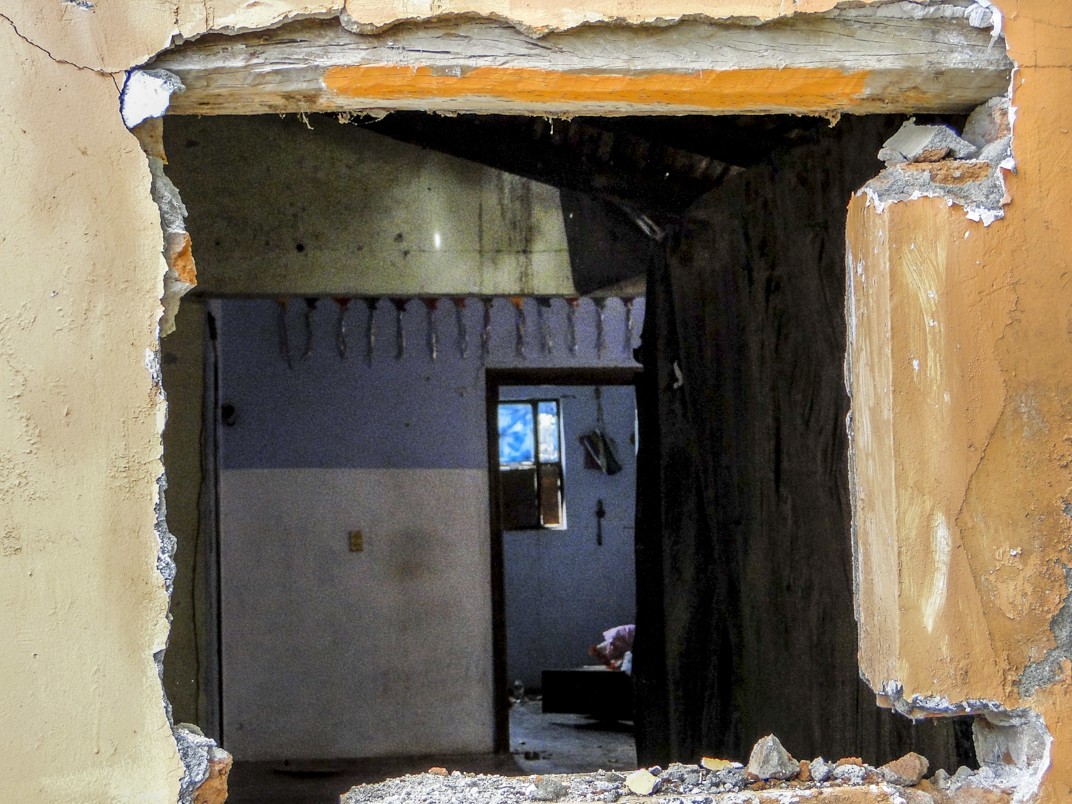Filed under: Analysis, Capitalism, Disaster, Featured, Southern Mexico, The State

By Renata Bessi and Santiago Navarro F.
October 11, 2017
Naomi Klein, in her book The Shock Doctrine, argues that the economic policies of Nobel laureate Milton Friedman and the Chicago School of Economics have gained importance in countries with free market models not because they are popular, but rather because through the impacts of disasters or contingencies on the psychology of society, in the face of commotion and confusion, unpopular reforms can be put into place.
It has been little more than a month since September 7, when the strongest earthquake of the last 100 years in Mexico hit, at 8.2 on the Richter scale. The landscape in the Isthmus of Tehuantepec, the region most affected, is still one of devastation. The city of Juchitán de Zaragoza resembles a ghost town. Wherever you look, there is debris or damaged buildings. The police and military still roam the streets, heavily armed.
The earth has not stopped shaking. Strange sounds emanate from the depths of the sea on the shores of Oaxaca. It is possible to feel tremors every hour. Mexico’s National Seismological Service has registered more than 6,000 aftershocks, in addition to a second earthquake with a Richter scale reading of 7.2 that happened on September 19 and devastated several sites in Mexico City, where 369 deaths have counted as of the October 4.
Official data from the government of Oaxaca state that the earthquake affected 120,000 people in 41 municipalities, as well as 60,600 homes, of which 20,664 were destroyed and 39,956 had partial damage. Its infrastructure, drinking water, and drainage networks are damaged. The local economy has been hit. Garbage is piling up in the streets. There is concern about a possible health crisis.
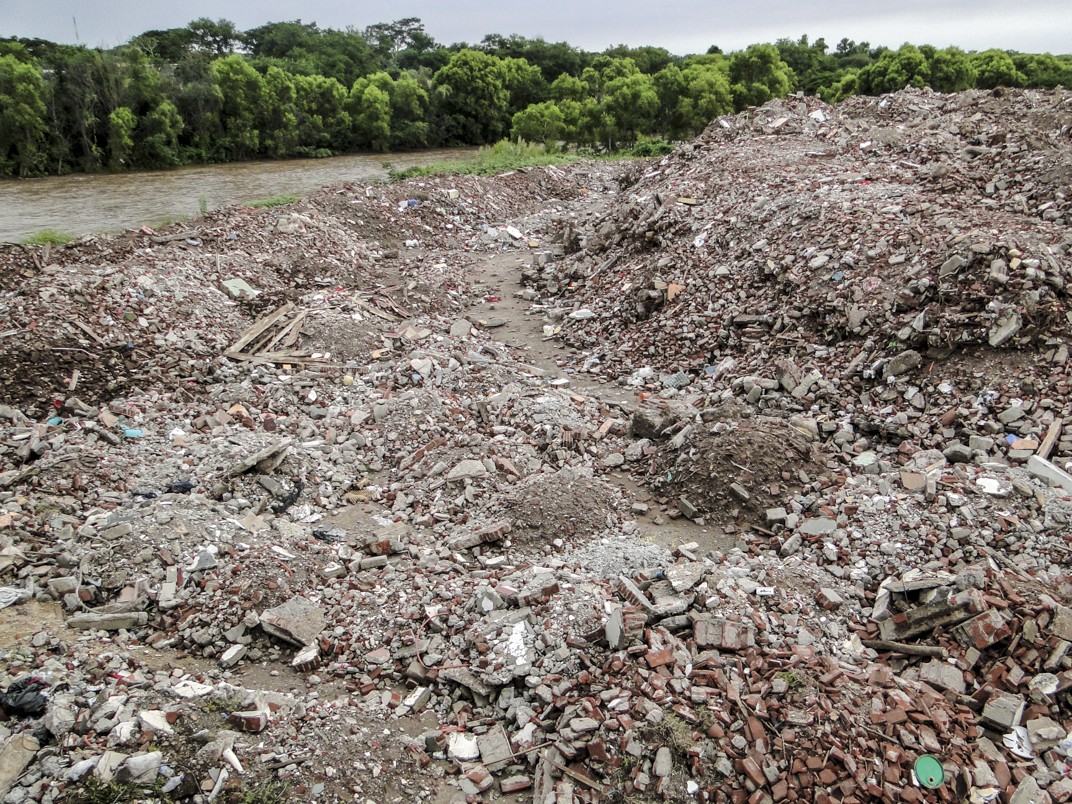
Rubble from buildings demolished by the government dumped on the banks of the Los Perros River in Ixtaltepec.
The municipality of Ixtaltepec, one of the most affected regions, resembles a war zone. Equipment from the government or the wind companies that dominate the region is indiscriminately demolishing anything declared as a total loss, including at least 80% of homes. Some of the neighbors have rescued what they could and decided to leave the community. Uncertainty has taken by storm the dream and tranquility of people who resist abandoning their homes, their community and their history. “I’m not going to leave here, because this is my home, here are my roots, here is my people,” says Joaquín Sánchez, from Ixtaltepec.
The colorful tents and tarps stretched out in the middle of the streets and in the courtyards of houses have become part of the everyday landscape of the towns in the Isthmus. For more than a month since the disaster, communal kitchens and tents created by neighbors in public spaces, with their own resources or through donations from civil society, have been the only alternatives for these populations. State shelters are almost non-existent.
In the municipality of San Mateo del Mar, for example, where 80% of homes were affected, the state’s response was to send the Navy five days after the earthquake to set up a shelter. However, they were superseded by the organization of the community, who sought ways to solve their most immediate needs. For those who lost their houses in the quake or whose houses were demolished by order of the state, they have only the streets or the houses of family and friends to sleep in.
Seven civil organizations carried out a Humanitarian Aid Observation Mission (MOAH), which toured communities in the area of Isthmus of Tehuantepec. In their initial conclusions, the organizations noted that “the urgent basic needs of the people affected by the earthquake have not been met; and that there is a lack of government coordination in the distribution of humanitarian aid.” They also denounced that the “candidates and public officials have fallen into opportunism by conditioning humanitarian aid, which was only delivered to people close to the government or to supporters of certain political parties after meeting certain conditions.”
“We must prevent them from erasing our memory”
The immediate policy of the state was to carry out the demolition of houses. In the municipality of Ixtaltepec, for example, the neighbors report that demolitions began hours after the earthquake. “The earthquake was around midnight and at dawn the machines were ready to start the demolitions, without any legal ruling or expert review,” says a resident of the municipality who prefers not to be identified for safety reasons.
“This policy of destruction comes from the federal government, without serious expert review. Peña Nieto has already said: ‘I invited my developer friends to come and rebuild.’ Who are these developer friends of Peña Nieto? Well, they’re not the local masons or engineers. They are the ones that are connected with the plans of those above. So what these companies need is for the territory to be cleaned so that they can act. It’s a business for big builders. People are scared; they are in shock and what the government is doing is taking advantage of the fear of the people, “said engineer Gerardo de Gyves Ramírez, member of the Regional Council for the Reconstruction of Our Towns, formed by organizations and residents of the Isthmus.
On September 15, the residents of Ixtaltepec submitted a request to the federal government that it make public the standard by which the state considers a property “damaged”. So far, the government has opposed making this standard public.
One of the demands of the Council is that a serious study of houses be done that evaluates the true conditions for their reconstruction. “The house is a fundamental part of the culture of a people. We have a traditional architecture that the people of the Isthmus have developed for centuries. They are large houses with large courtyards. People spend most of their lives in the open spaces, outside the interior. Changing a way of life is to change its customs. How one thinks depends upon how one lives. You do not think the same when you live in a small, enclosed apartment as you do when you live in a big house with big green space, outdoors, in which you know you have history, “says Ramirez.
The Isthmus of Tehuantepec is a region rich in culture and traditions as a result of the different ethnic groups that inhabit the area – Zapotecos, Chontales, Huaves, Zoques, Mixes, Mixtecos, Tzotziles and Chinantecos. “The first thing we must prevent is the erasure of collective memory,” said Jehú Pinacho of the Autonomous Research Group.
Stop the Demolitions
In Unión Hidalgo, residents formed the Citizens’ Council for the Reconstitution of Unión Hidalgo precisely to prevent the destruction of houses. So far, the state has carried out 100 demolitions. The work brigade stopped 300 demolitions of traditional houses. “When we became aware of the government’s strategy, we reacted. There is a brigade of architects and engineers touring Unión Hidalgo and making reports and raising public awareness about the government’s strategy,” said Carlos Manso, a member of the Council.
The same work is being done by the Council for Reconstruction and Strengthening of the Community Fabric of Ixtepec. “We set ourselves up as an organization and began to remove debris and recycle material that is being used to repair farmers’ roads. We also started to visit the houses with technicians and of the ones we visited, 70% are recoverable,” said one of the members of the Council of Ixtepec.

BIBANI, the Autonomous Reconstruction Project, was created after the earthquake and has proposed a rebuilding plan based on the needs and cultures of the peoples of the Isthmus.
The Card
The president of the republic, Enrique Peña Nieto, announced on October 2 the delivery of bank cards on which $6,478 dollars will be given to those who lost their homes. Those who were classified as a partial loss will receive $1,619. Immediately after the announcement, a row of trailers arrived loaded with construction materials and a sign that read: “This establishment accepts the card to buy materials.”
In addition to the meager amount offered for the reconstruction of houses, the card represents a problem for various communities when considering the construction of traditional houses. In coastal communities, for example, where traditional houses are made of palm fronds and wood, they will not be able to buy such material from construction stores that accept the card.
Pedro Davalor Larrinzas, a municipal authority of San Mateo del Mar, explains that in the municipality there is still the problem of houses that were damaged after the earthquake on September 7, with the aftershocks and the earthquake of September 19, but they were not accounted for by the government. In addition, “state officials in many cases refused to consider palm houses as homes and, therefore, they were left without the possibility of help,” said Larrinzas.
He explains that there are many other problems in cities and communities that the state is not paying attention to. “Most septic tanks, for example, were ruptured because we do not have a drainage system here. Solving that is urgent so as not to worsen the looming health crisis.”
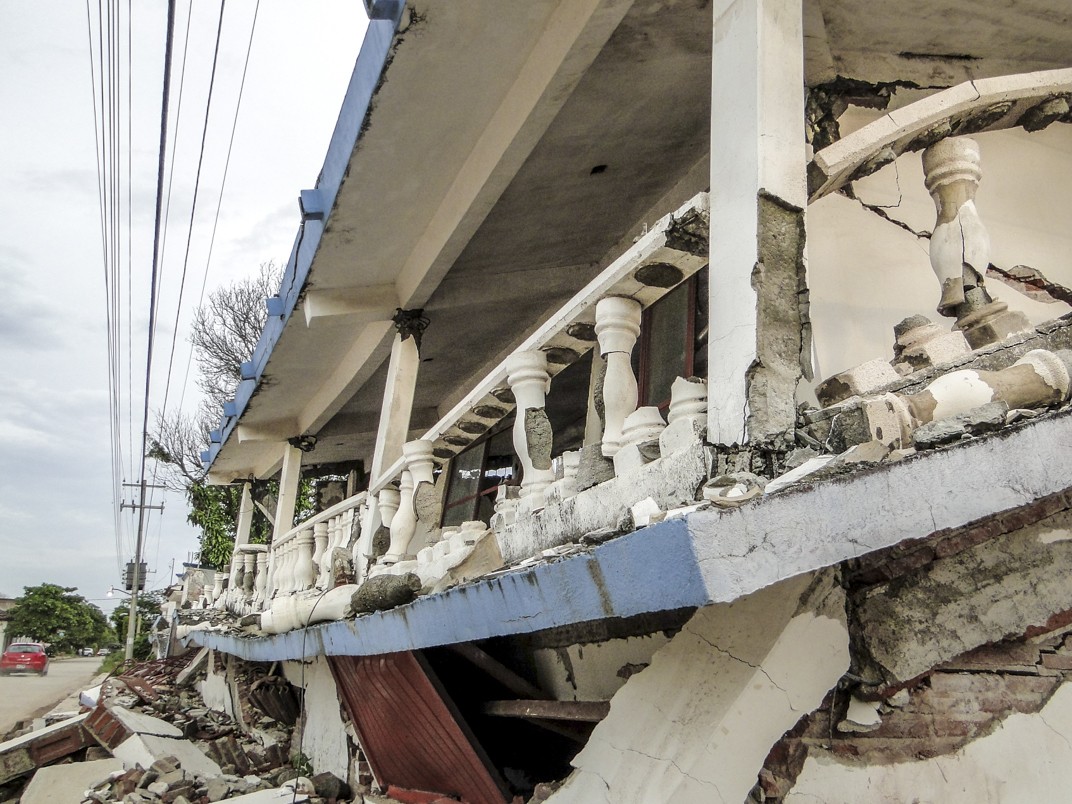
Lack of Reliable Scientific Reports
The Regional Council for the Reconstruction of Our Towns denounces that scientists have been notable for their absence in the Isthmus of Tehuantepec. “All they have done are press releases and press conferences from the center of operations that is Mexico City. We have not had a visit from any independent research institution. Only the commissioners from the federal government have come,” said Fernanda Latani, a member of the council and of the Ixtepec feminist collective Granddaughters of the Binnigulaaza.
Since the earthquake, the people live in anxiety about what is happening. In San Mateo del Mar, for example, people report that the sounds from the sea continue. “No institute, no geologist came to tell us what conditions we’re under. The aftershocks still continue and we still hear sounds from the sea and we have no idea what it is. And that creates much uncertainty. We are in an uncertain situation of how to live and how to move forward,” said Juan Bernardo Fernández, a resident of the community.
In addition, he says, aid for reconstruction must be different for each of the communities. “We, people who live by the sea – San Mateo del Mar is surrounded by water; it is a small peninsula, approximately 40 km long and 3 km wide, the Pacific Ocean to the south and a lake called Mar Muerto to the north – we have different needs from those who live on firmer ground, such as the center of Juchitán, for example. We are in a region of sandy soil. We do not have any technical reports, but what we saw was that, with the earthquake, the ground made a movement upwards and then very abruptly sunk down. Many houses sank and people could not open their doors to get out. Elsewhere, cracks opened in the soil and water began to flow out. Four people were even swallowed up by the cracks,” Fernandez says. Thus, “it is not possible to simply treat all regions in the same way, even though they are close to one another.”
“There is no official, serious, responsible or sufficient geological information in a language accessible to the majority on the event and its consequences,” a Council statement said.
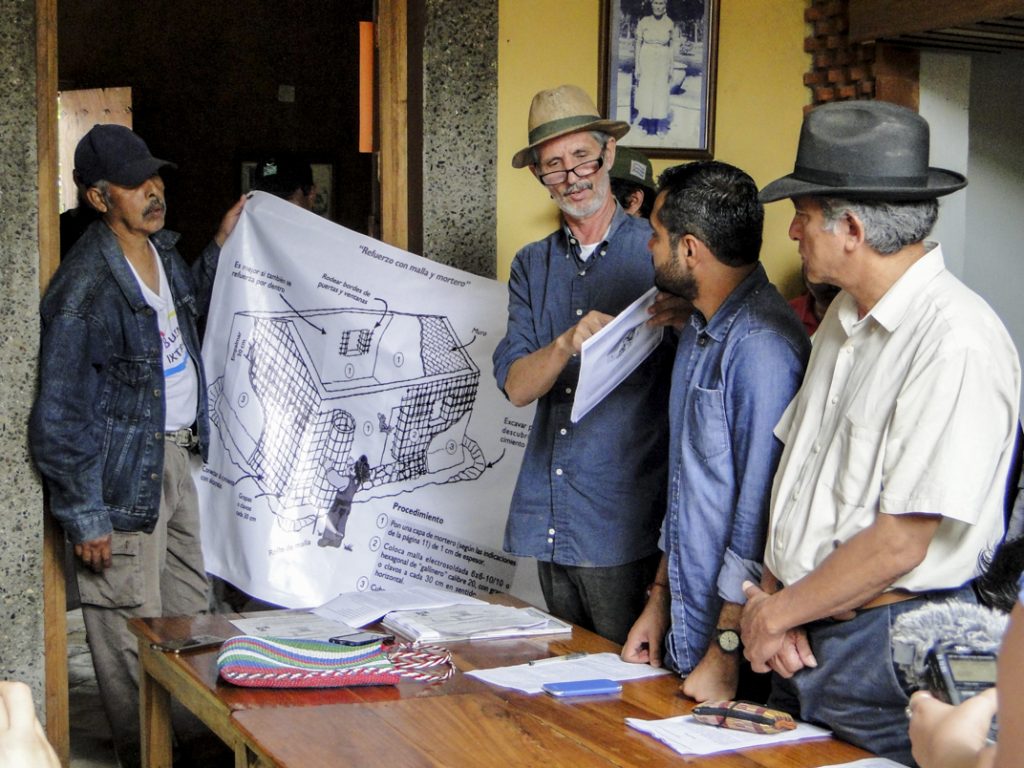
Demands from the Regional Council for the Reconstruction of Our Towns
Immediate temporary housing for families who were left homeless by the earthquake or by demolition by the authorities.
Immediate end to the destruction of traditional dwellings, as well as the pressure on the owners by the authorities, as it subverts the family and cultural heritage and identity of our peoples, which on the contrary they should be protecting. Instead of destroying, they should reinforce the houses for later reconstruction.
We categorically reject the imposition of housing prototypes that have nothing to do with the culture and identity of our peoples, as well as the participation of large construction consortiums that will take the majority of economic resources. We demand self-construction processes with materials from the region, structurally improved, with adequate consultation.
Immediately carry out a geological study program to determine the appropriate way to build homes in our region.
Implement a contingency plan to prevent a possible health crisis resulting from the unhealthy conditions in which a large part of the population lives.
Immediately stop the confiscation by the armed forces of humanitarian aid that social or private agencies want to get directly to those affected and who still remain in the process of reconstruction.
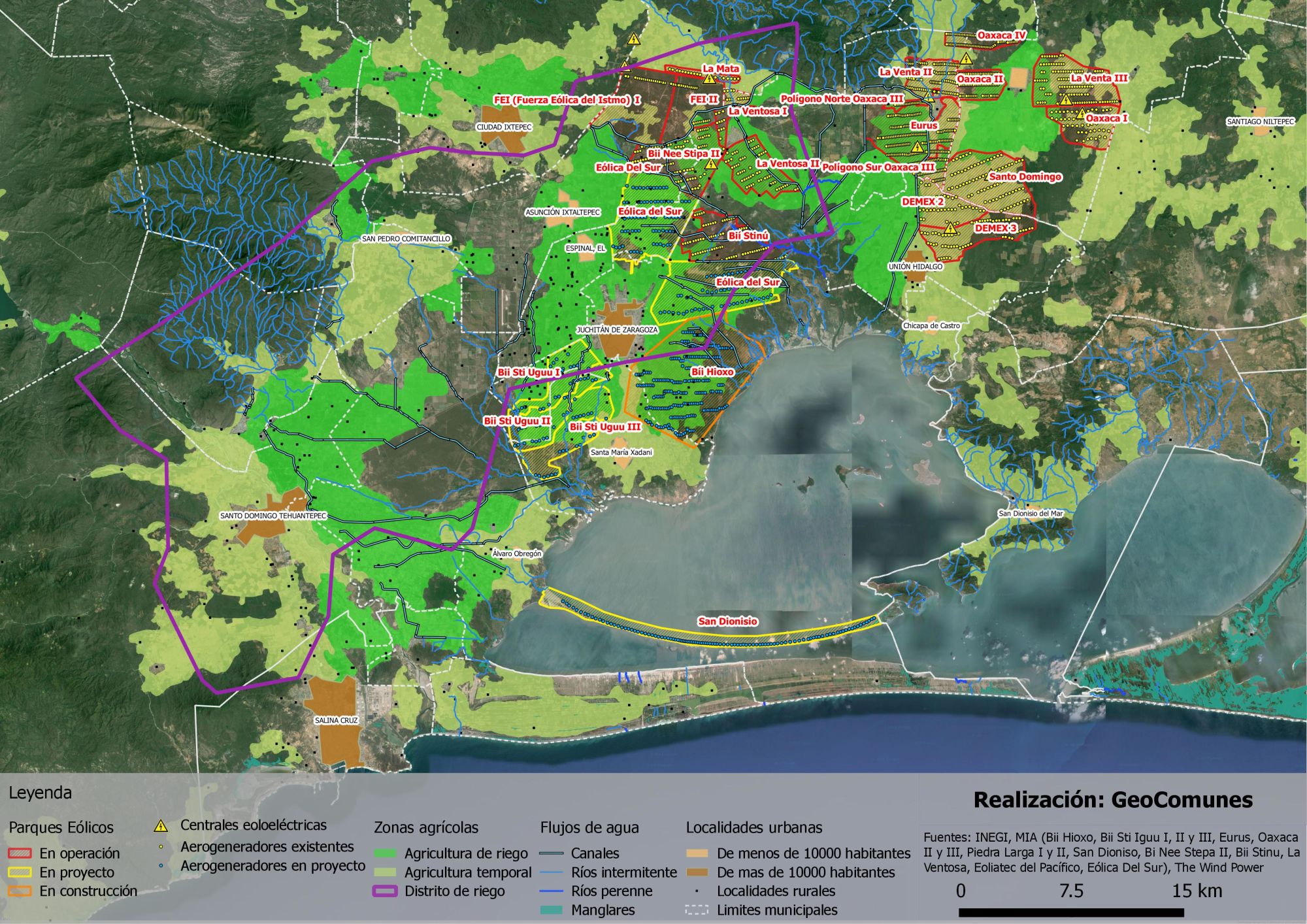
Map of wind farms in Oaxaca. See the Avispa report “The Dark Side of Clean Energy in Mexico” for more.
Strategic Region
“Seven days after the earthquake, they came to my house and ruled that it was total damaged. They simply said to me: ‘Lady, look for a place you can stay because you cannot live here.’ And they demolished the house. A government worker arrived saying it was not a suitable place to build a home and told us that the government was going to find another place to relocate our home. So I told him: how are they going to relocate us if our ancestors have always lived here?” says a resident of the municipality of San Mateo del Mar, Reina Gutiérrez Ruiz. “It is not relocating that will help us. If they really want to help us, it’s necessary to do a study to tell us what kind of houses to build and with what materials,” she said.
This is a recurrent account from the residents of the community. “We cannot expect blessings from the government; we are a hindrance to the government. For them it would have been better if the earthquake had completely ended our people,” said Beatriz Gutiérrez Luis, an indigenous education teacher, a member of the Coalition of Indigenous Teachers of Oaxaca and resident of San Mateo del Mar.
The professor’s statement is based on the fact that her people have been resiliently fighting against megaprojects that have been present in the region for at least 15 years. “The government has an interest in the people leaving its territory,” she says. “Our lands are coveted. Although through our assembly we rejected the wind farm megaproject, the government wants to install a park on our land. In addition, we know that there are mining concessions and we will not allow that.”
In the Isthmus there are 1,916 wind turbines and the government plans a second phase of installations. Beatriz Gutiérrez Luis summarizes how the process went in her community:
In the year 2000 the intrusion of the parks in the Isthmus began. Information began to circulate here in the community about projects in other communities, but we did not think it would reach us. In 2003, a radio was installed here in the community high school, and they began to report more consistently on the projects in the Isthmus. In 2005, it began to be said that a park was going to be installed here in the community. In 2007, a Spaniard arrived here in our community, specifically to one of the town’s assemblies, to say that they were going to install the park. And the assembly replied that it was not. He told us that it would bring us many benefits: the building of roads, of schools. And we said no. One of the main reasons why we resist is because of the deep spiritual relationship we have with the land and with the sea. And we already had information of what was happening with other neighboring communities, just due to awareness through the radio. But yes, we are a thorn is their side.
In Unión Hidalgo, where neighbors have managed to stop the indiscriminate demolitions, there is an offensive by the state and companies for the installation of a new wind farm – today there are 114 wind turbines in the community that were installed by the Demex company. “Before September 7, we had a different momentum. There was the question here of the consultation that was about to be carried out for the installation of new wind projects. We are critical of these projects because we have not seen development for our communities,” said José Arenas López, a resident of the community and a member of the Binni Cubi Collective, which runs a community radio station in Unión Hidalgo.
First, he continues, “we would have to discuss what is meant by development and who develops with all that. Throughout Isthmus there has never been a focus on the benefit of the community. We have seen the amount of resources produced with our resource, the wind, but it has not served our people. For example, Demex produces at least an average of 323 million pesos per month. It is not a development that includes our communities,” he says.
In addition, the environmental, social and cultural impacts of the parks are not discussed. “Everything is understated when there are studies that discuss the death of bats and birds. For example, in the wind farm La Venta 2, with 98 wind turbines, there was a study in 2010, with one year of observation, and they found 6,000 dead bats, and 3,600 dead birds. If we extrapolate that for the proportional amount of installed wind turbines, it is an impressive amount that should concern us as a community. And what they want is to surround our town with wind turbines. There are communities like La Venta, that is a community condemned to disappear,” he said.
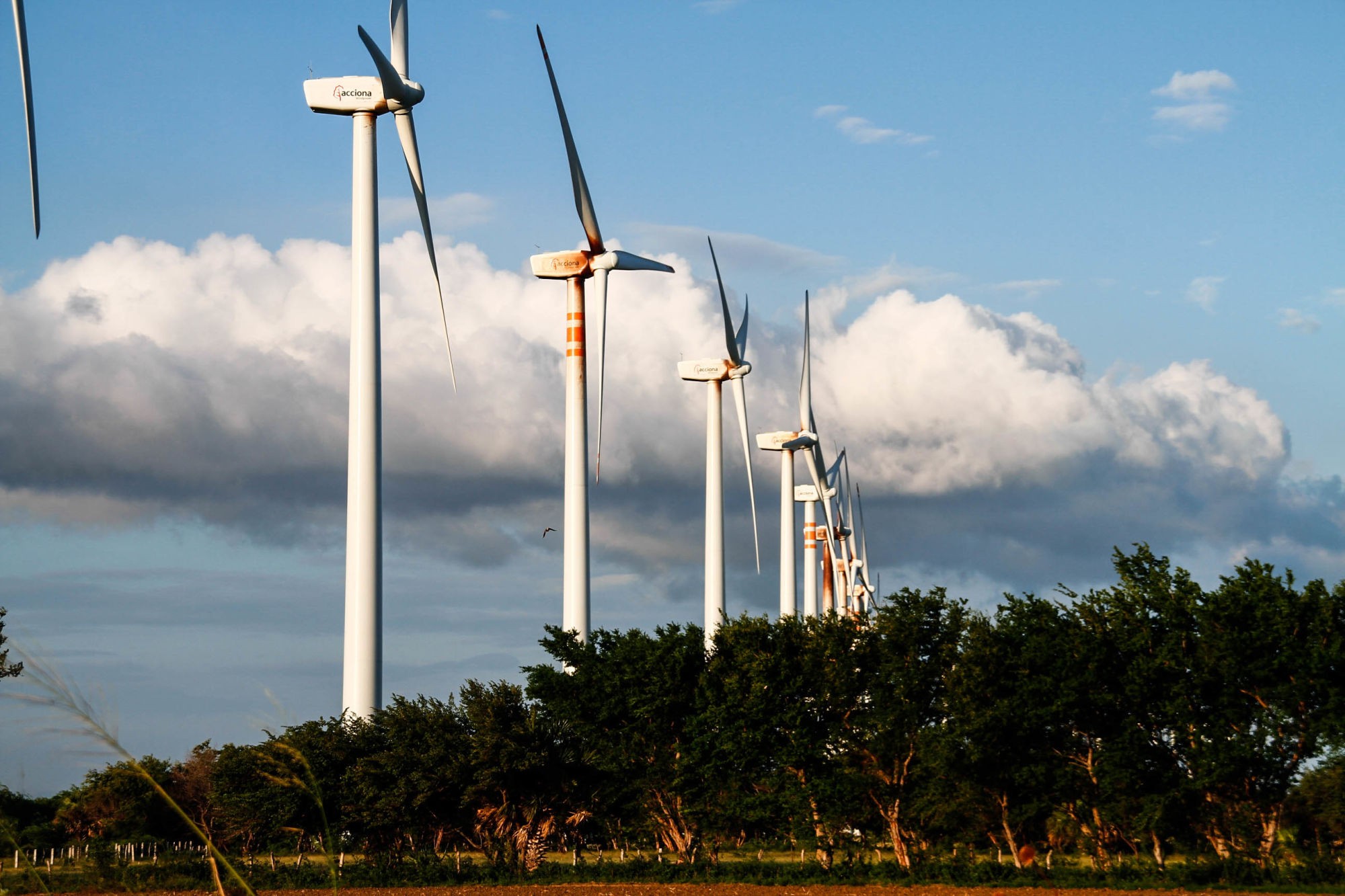
In López’s account that follows, about the consultation the government wants to conduct in his community, the business referred to is Empresa Eólica de Francia (EDF):
What we have noticed is that the companies, along with the people who have advocated for them, have gone to the schools and have done some charity work so that when the consultation happens, people thank the companies because they built a bathroom, or because they built a well, because they handed over a trophy. So, when that is done before the consultation, well, it’s not done in good faith, because it is pushing the consultation in a certain direction.
Also, what they are trying to do is to intimidate people who do not think like them. They say that we are opposed to development. These companies have already defined the project; there is already approval of the wind projects by the Secretary of Energy, including even the dimensions and quantity of wind turbines. So, when they refer to prior consultations, it has nothing to do with prior. The project, in this case, is already developed and defined. International agreements mention prior, free and informed consultation about the development of the project. The first to not respect the laws is the state itself. With these situations, it is clear that what they want to create is a process to legitimize the entry of more wind projects. In days of panic like the ones we live in, it is easy to control frightened people. The people themselves are the ones who must find a mechanism to reorganize themselves and be able to face everything that is coming.
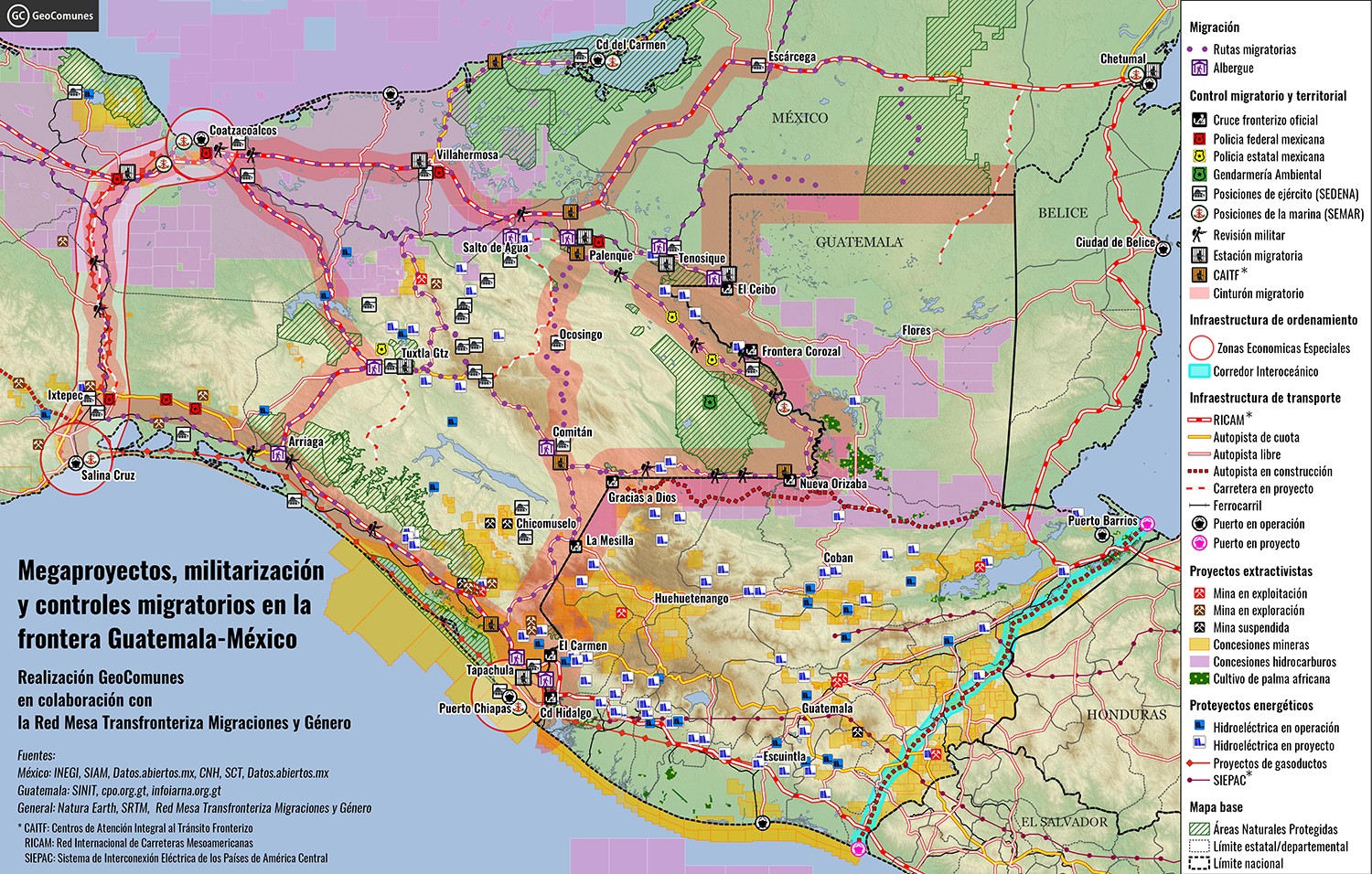
Map of megaprojects, militarization and migration controls in the Guatemala-Mexico border region.
As well as San Mateo del Mar and Unión Hidalgo, historically the entirety of the Isthmus of Tehuantepec is prized for its natural resources. “The looting of wood, oil, water, minerals and energy has been uninterrupted,” says Luis.
In addition, the southern border of Mexico is a strategic area as it is a transit corridor between Central America and North America, both for goods and for migrants. For this reason, the region is being considered for different neoliberal development plans, such as the Mesoamerica Project and, more recently, the Special Economic Zones (Zonas Económicas Especiales) or SEZs. That is to say, a territorial demarcation that has very specific conditions granted based on a public policy that the government has established to make it highly attractive to investment. The government’s objective is to generate the necessary conditions to accelerate the installation of megaprojects.
The economic control of the region is complemented by population control plans such as the Southern Border Plan (Plan Frontera Sur), which, with the support of the United States, was designed to manage the movement of migrants en route to the United States and, with the justification of combating drug trafficking, maintain the presence of different security forces, which facilitate complete control over this strategic area.
And with the earthquake, the communities were over-militarized. “There is a direct intention to militarize as much as possible in order to have control over the physical, territorial, and psychological spaces. All disguised as humanitarian aid. That’s just swell,” says Luis.
Elements of the army and police, says Pinacho of the Autonomous Research Group, have only served “many times as spectators, while the inhabitants organized themselves to clear rubble and organize brigades in their neighborhoods and communities.”
In addition, they act in complicity with the wind companies. “An example is the case of Unión Hidalgo, where residents reported that elements of the Navy were hoarding food shipments sent by civil society and then allowing the wind company EDF to label them with their name. Later they left, accompanied by the Navy, to distribute them in the streets of the town,” explained Pinacho.
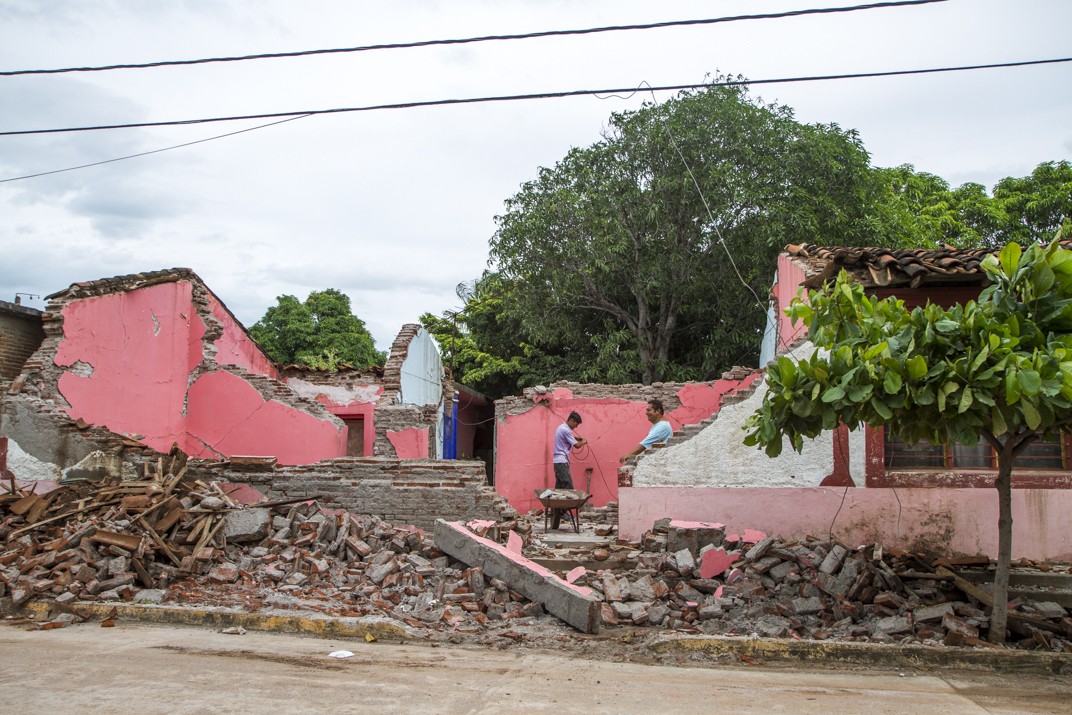
Opportunism
The region of the Isthmus of Tehuantepec has already undergone an initial territorial reordering beginning with the creation of more than 20 wind farms established on communal and ejidal lands, highways, power lines, pipelines and gas lines, which were planned since 1999 with the Mesoamerica Project – initially called Plan Puebla Panamá. This economic integration project that covers the seven countries of Central America has been advised and subsidized by the World Bank (WB) and the Inter-American Development Bank (IDB).
The government of Mexico has been coordinating the construction of a Special Economic Zone (SEZ) in the Isthmus, which would include the area affected by the earthquake. Indeed, the disaster has meant an opportunity for politicians and businessmen. Two days after the earthquake, the head of the Federal Authority for the Development of Special Economic Zones, Gerardo Candiani, thought it necessary to accelerate the process of constructing the region’s SEZ with the aim, according to him, of reviving the locations affected by the devastation left by the earthquake.
Special Economic Zones
According to the official website of the Mexican president’s office, a Special Economic Zone (SEZ) is a geographically delimited area, located in a site with natural and logistical advantages to become a highly productive region. It is a legal, fiscal, customs, labor, immigration and special business and exchange scheme.
The objective is to attract foreign direct investment from transnational or multinational companies that, in turn, according to the Federal SEZ Law, seeks to “democratize productivity, at the regional level, so that the inhabitants of the south have the same opportunities for development and well-being as the rest of the country.”
The Federal Law on Special Economic Zones enacted in 2016 was jointly designed by the World Bank, the Inter-American Development Bank and Harvard University.
The powers of planning, promotion, regulation, supervision and verification in the area of Special Economic Zones, provided for in the Federal Law on SEZ, are delegated to the Federal Authority for the Development of Special Economic Zones – a decentralized agency with technical, operative and managerial autonomy.
The first modern special economic zone was created in 1959 at the Shannon airport in Ireland. Currently, it is estimated that there are 4,300 of these areas worldwide and that around 75% of countries have at least one. After three decades, China is considered the world’s largest economy and, according to World Bank data, has six SEZs and is the model for Mexico’s SEZs.
It is almost certain that Mexico will offer a broad labor market at very low cost, with minimum wages of no more than 60 pesos per day. Among other benefits that companies will have, according to the SEZ law, are: exemptions, without time limit, on import and export tariffs; 100% discounts on income tax for the first ten years of operations and 50% in the following five years; 50% tax credits for employer fees paid to the Mexican Social Security Institute (IMSS) during the first ten years of work; special VAT treatment and special customs regulations with reductions in fees, to name just a few of the benefits.
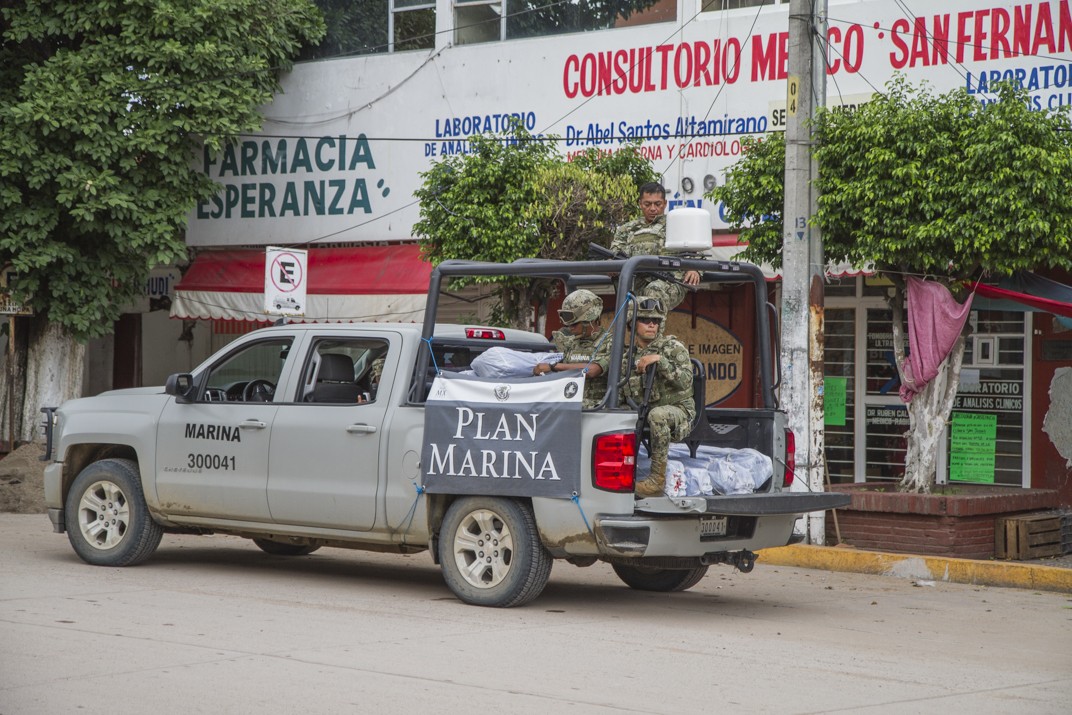
Marines deployed in the Isthmus after the earthquake.
The truth is that the SEZ establishes an area in which all the privilege is given to investors, who, in addition to the receiving tax exemptions, will have control over the circulation and security of the area. The design and planning of the SEZs was carried out by private consultants with the assistance of the Inter-American Development Bank (IDB). According to the Project on Organization, Development, Education and Research (PODER), this new federal government policy is a strengthening of the extractivist model and a step forward in the privatization of Mexican territory.
There is talk of creating these megaprojects with unconditional incentives for companies, but there is no reference to the branches of the popular economy that are affected and paralyzed. “There is no emergency plan to recover the economic networks of the people.”
“It is a very difficult context for us because the government is using the shock doctrine in our region and taking advantage of the devastation. People are afraid and more concerned with solving their immediate needs. At the moment of surviving the catastrophe and creating bonds between us, we have to see how to come together against the government’s major strategy, which is to displace us,” said Carlos Manso, a resident of Unión Hidalgo and author of the book Comunalidad, resistencia indígena y neocolonialismo en el Istmo de Tehuantepec, siglos XVI-XXI.
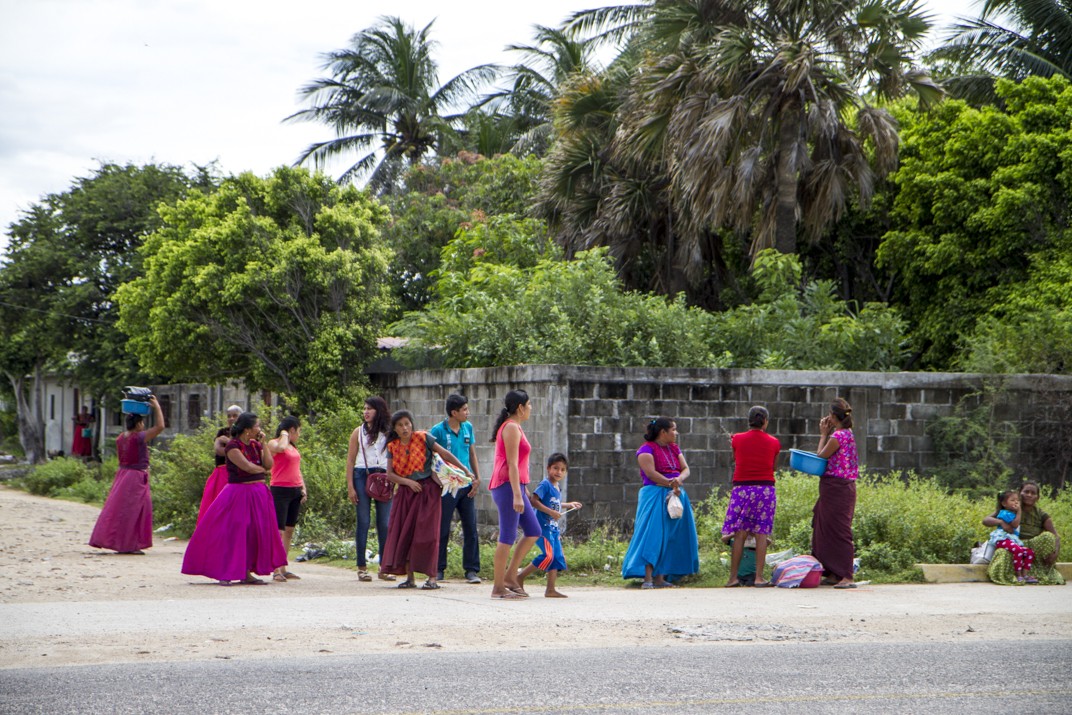
Communal Lands, Resistance
Days after Candiani’s statement, the federal government officially declared three SEZs: Puerto Chiapas, Chiapas; Coatzacoalcos, Veracruz; and Lázaro Cárdenas-La Unión, in the states of Michoacán and Guerrero. This declaration was made without first establishing a protocol that responded to the basic needs of the affected communities in Oaxaca or the state of Chiapas – which was affected by the September 29 earthquake.
For these first three SEZs, in Tapachula, Chiapas, the federal government acquired 522 hectares, but the designated site will encompass the municipalities of Tapachula, Tuxtla Chico, Suchiate, Huehuetán, Mazatán, Frontera Hidalgo and Metapa, in a net area of 8,216.51 hectares. In Coatzacolacos, Veracruz, the acquired area is 260 hectares with a site of up to 8,263 hectares, covering Coatzacoalcos, Nanchital, Ixhuatlán, Minatitlán, Cosoleacaque, Osteapan, Chinameca, Jáltipan and Zaragoza. Additionally, in Lázaro Cárdenas, Michoacán, the federal government acquired 369 hectares, but the area of influence will be up to 5,451 hectares, mainly in La Unión and Zihuatanejo, in Guerrero.
Although the Isthmus of Tehuantepec has not been declared an SEZ in this first stage, Candiani pointed out that the project has advanced 90% in the Oaxacan territory and that it will be declared an SEZ in the coming months, along with Campeche, Yucatán and Tabasco.
Oaxaca is a rural and indigenous state where social ownership of the land supersedes private ownership, where there is an emphasis on communal and ejidal land, which represents 76% of the territory. This is where the main problem lies in moving forward with the SEZ, the difficulty of privatizing the lands, since they are in the hands of indigenous people and campesinos.
Since the Federal Government reformed Article 27 of the Constitution, it implemented a federal program called the Program of Certification of Ejidal Rights and Certification of Urban Estates (Programa de Certificación de Derechos Ejidales y Titulación de Solares Urbanos), the main objective of which is to frame these lands in the modality of private property so that the companies or the government can buy them.
Oaxaca is one of the states in Mexico that has made slow progress in privatization. “Simply because private property would change our social relationships. Our customs and traditions are maintained because our territory is collective,” says Arenas López.
Under the argument of “for a better response to the demands of society, it is necessary to regulate the land to collect property taxes,” according to the government of the state of Oaxaca.
In April of this year, the municipal council of Salina Cruz, chaired by Rodolfo León Aragón, signed an agreement with the Commission for the Regularization of the Tenure of the Urban Land of the State of Oaxaca (Coreturo), in order to regulate lands where there are human settlements considered irregular by the state, and make them private, state or municipal property.
The 90% advancement for the SEZ in the Isthmus of Tehuatepec, of which Candiani speaks, revolves around that regulation of lands. One month after the signing of this agreement, in May of this year, Candiani informed us that he already had 1,230 hectares in Salina Cruz to grant to investors. Additionally, the “expanded site” will exceed one thousand hectares.
The territorial reserves in Salina Cruz are communal or ejidal lands and are being purchased for between 40 and 50 pesos per square meter. They are then sold to the companies that will invest in the SEZ. “The whole industry is on ejidal or communal lands; we sold it to a car dealership under this scheme, and then they went through the procedures to regularize the land. They turned it into private property, and the price of the place rises considerably,” said Enrique Alcalá, a real estate specialist, to the local media Nvinoticias.
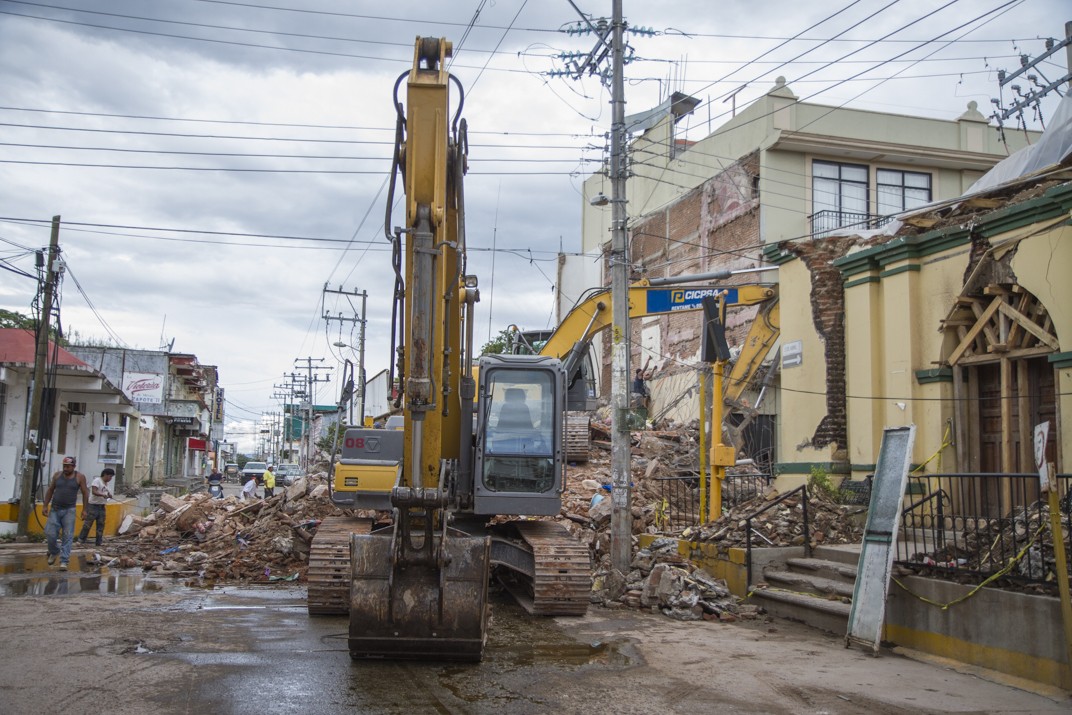
Rejection
The organizations, communities and people of the Isthmus of Tehuantepec gathered in Oaxaca in July 2017 at the Special Economic Zones and their Implications in Community Life and the Environment Forum, rejected the implementation of SEZs in the Isthmus of Tehuantepec and anywhere else in the state.
Their intentions are evident; they have announced and promoted mines, new wind farms, electrical substations and transmission lines, steel mills, gas pipelines and terminals, hydroelectric dams, and the construction of railways and roads. All of these industries of dispossession and destruction are grouped, organized and legitimized by the legal, fiscal and administrative scaffolding provided by the SEZ law and so-called structural reforms. A new wave of devastation is foreseen for the Isthmus and the entire state. International capital and the Mexican political elite hover over Oaxacan territory with greed, eagerness and rapacity. These new times of a capitalism are increasingly crude, delusional and genocidal.
The false model of the green wind farms industry has not only stripped land and bodies of water from the campesinos of the Isthmus, but has also corrupted and destroyed the social fabric. The false model has led to the violation of human, social and environmental rights, facilitated by judicial authorities in collusion with authorities of all levels, in addition to promoting extralegal and paramilitary violence. They are the spearhead of the extractive and predatory industries that today are given shelter under the SEZ laws that they benefit from.
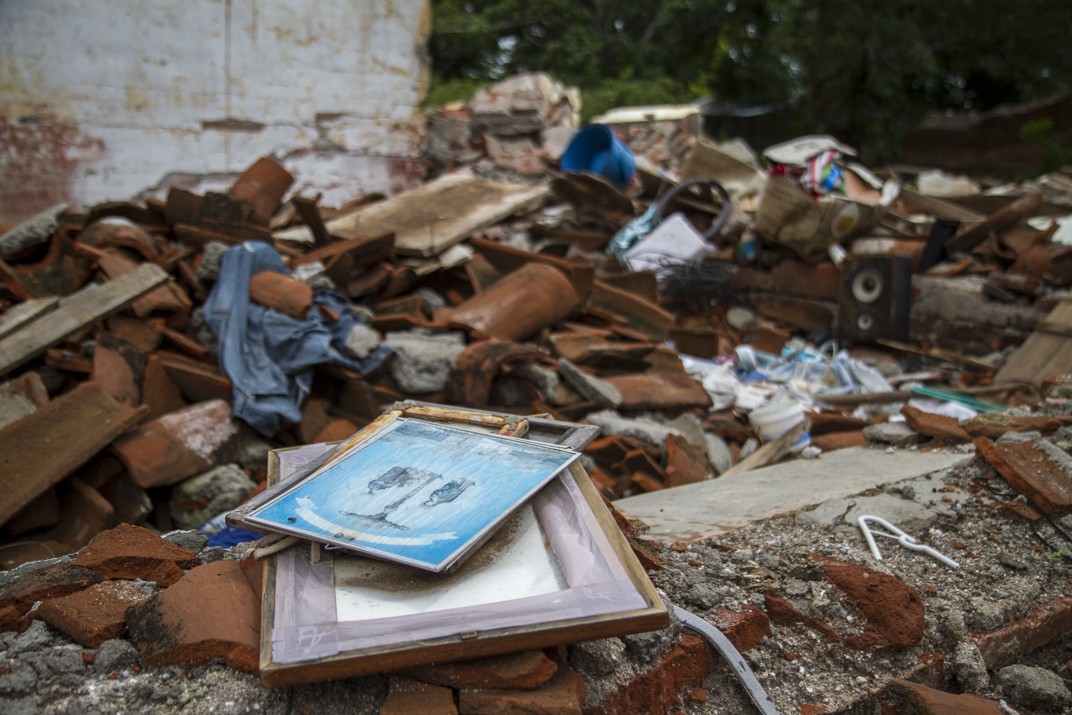
Information Under Seal
The federal government classified the feasibility studies, draft opinions and diagnoses related to the design of the Special Economic Zones as confidential information for five years, all of which was data generated by private consultants for the design of the SEZs.
In response to a request for information made by the newspaper Sin Embargo, the National Bank of Public Works and Services (Banobras, which was designated by the federal government to design the SEZs), answered:
“The information concerning the twelve documents corresponding to four pre-feasibility studies, four draft opinions and four reports on the inspection results and the list of potential full managers and investors was indexed as classified for a term of five years, and until the end of the deliberative process, because it is information that is directly related to decision-making, taking into account that its dissemination may interrupt, undermine or inhibit the design, negotiation or implementation of matters submitted for deliberation,” Banobras responded.
Production towards the USA and China
The United States and China have significant interest in the SEZ. In 2009, the United States Agency for International Development (USAID) presented a report entitled “Study of Wind Energy Export Potential from Mexico to the United States.” The document stated that, due to the high demand for renewable energy in that country, Mexico was a potential exporter of wind energy to the states of California and Texas. The two most important wind power generation complexes in Mexico are the Isthmus of Tehuantepec and Baja California.
China has also shown interest in investing in the SEZs, especially in the administration of these areas, which implies the construction, development, management and maintenance of these areas, in addition to its interest in the steel industry, metals, agroindustry, and information technologies.

Sustainable Cities
Luis Alberto Moreno Mejía of Colombia, former Minister of Economic Development and current president of the Inter-American Development Bank (IDB) attended the event declaring the SEZs on September 29. In September 2016, Moreno, in conjunction with the Ministry of Finance and Public Credit, signed an agreement through Banobras for the implementation of the Program of Emerging and Sustainable Cities (PCES) within the SEZ’s area of influence. At the event, he affirmed, “there are few sites in Latin America that have zones as ambitious as those that are being created here in southern Mexico.”
To date, three Mexican cities are part of PCES: La Paz, Baja California Sur; Campeche, Campeche; and Xalapa, Veracruz. However, the initiative will be extended to more cities, including some that will be part of the Special Economic Zones (SEZs), such as Lázaro Cárdenas, Michoacán; Coatzacoalcos, Veracruz; Salina Cruz, Oaxaca; and Tapachula, Chiapas.
“We must pay attention to what they consider sustainable cities, which are paired with the SEZs. In various places in Latin America, this city model is accompanied by an intense process of ‘gentrification’, that is, displacement of poor people from places they want to ‘reclassify’”, says Pinacho.
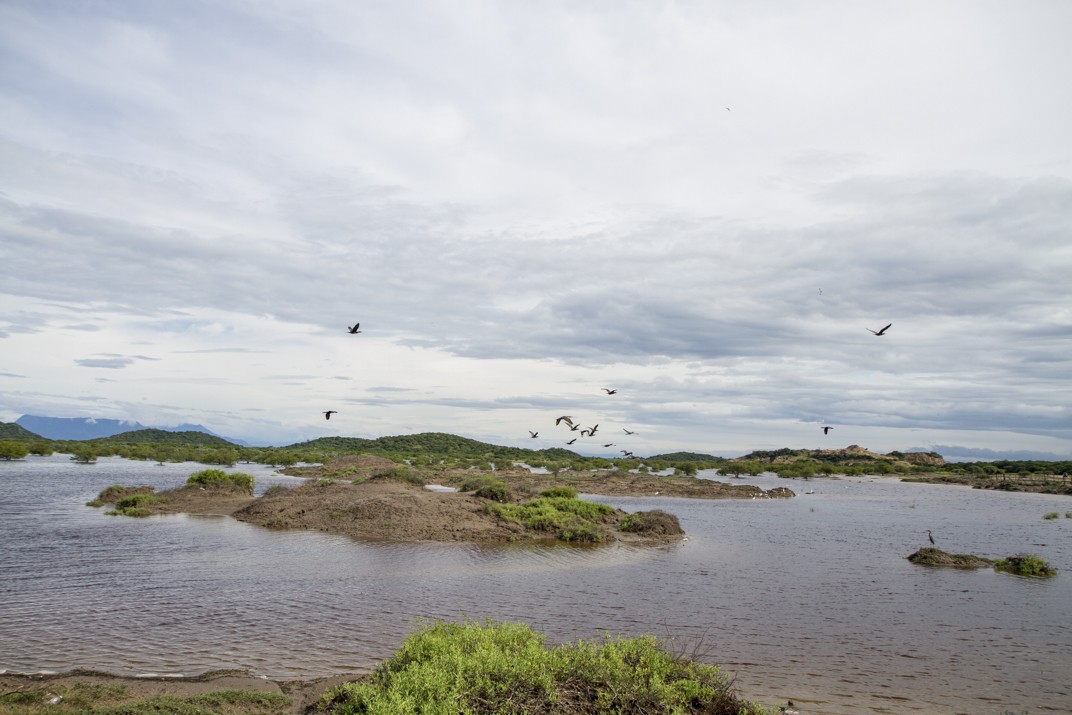
Communal Existence
Indigenous people remain firm in their fight against the SEZs. Days before the earthquake, on August 22, within the framework of the Extractivism or Life National Forum, representatives of social organizations from 23 municipalities in the Isthmus agreed upon their rejection of the SEZs. In their final agreements, they argue that they oppose extractivism and SEZs because they are industrial models that destroy nature and the commons and directly affect the local labor force, traditional seeds such as corn, and the means of living such as water and energy.
“Our resistance is rooted in the communal existence of the peoples in the defense of agrarian communality, of our way of life. These elements of resistance are present and, of course, form the basis of our actions as we look for ways to communicate and from there to resist, even in this context,” said Carlos Manso.



